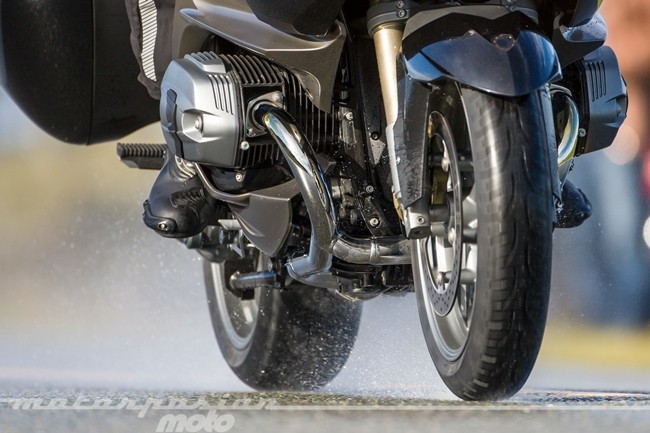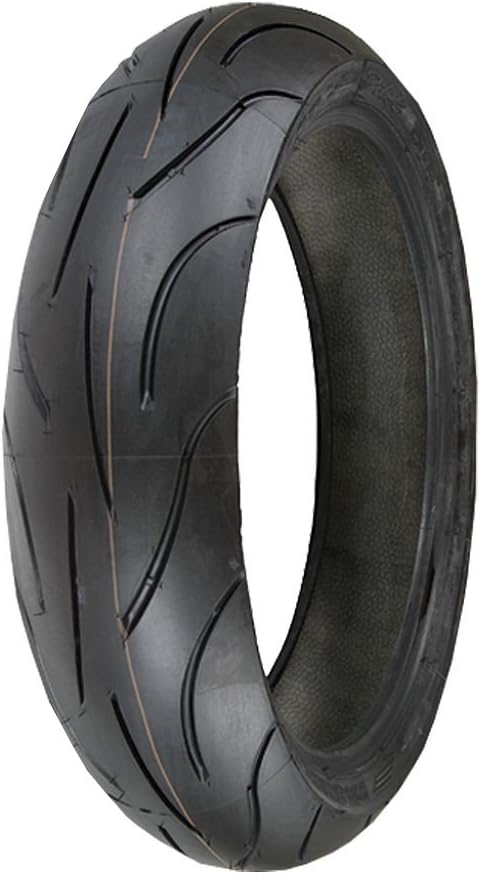Introduction to the Michelin Pilot Road 4 Tire
Greetings! I’m Gerard, and I’m thrilled to provide you with an in-depth analysis of the latest addition to Michelin’s stellar lineup: the Pilot Road 4 tire. Before us are two distinct sets of tires: the older Pilot Road 3 and the newly unveiled Pilot Road 4.
With the latest iteration, Michelin builds upon the legacy of what has been lauded as a standout tire for the sport touring enthusiasts.
What’s New with the Pilot Road 4?
The Pilot Road 4 comes with a promise: improved handling coupled with greater longevity. In fact, it’s not just a marginal improvement. Michelin asserts a staggering 20% enhancement in lifespan over its predecessor. While we’ll delve into the specifics in a bit, it’s worth noting why one might opt for the Pilot Road 4 in the first place. We’ve often referred to the Pilot Road 3 as the “Goldilocks” of tires – it was just the perfect fit for an array of applications. The Pilot Road 4 simply elevates this legacy to new heights.
Variants of the Pilot Road 4
There are three primary versions to consider:
- The standard Pilot Road 4: This variant boasts dual compound technology for both the front and rear tires, and it’s tailored for 17-inch rims.
- The Pilot Road 4 GT: Designed specifically for the grand touring segment, this version is perfect for larger bikes, especially those loaded with luggage or with a pillion. If you’re a rider of, say, an R-1200 RT, this tire, with its robust and stiffer structure, is an ideal match.
- Lastly, the Pilot Road 4 Trail: This is the go-to tire for the hefty dual-sport motorcycles. Think of machines like the 12 GS or the KTM 990 Adventure. With this variant, riders can also expect diverse front tire size options.
In summary, Michelin continues to demonstrate its commitment to innovation and excellence with the Pilot Road 4. Whether you’re a daily commuter, a touring enthusiast, or an adventure seeker, there’s a Pilot Road 4 tire tailored to meet your specific needs.
Michelin Pilot Road 4 Trail: Exclusively for On-Road Use?
Indeed, the Michelin Pilot Road 4 Trail is designed exclusively for on-road use. Emphasizing handling and longevity, it stands as a testament to Michelin’s innovation in tire technology. The all-season silica-charged compound has been further refined in this version, ensuring optimal grip in diverse road conditions. An aggressive tread pattern further enhances the tire’s adaptability, ensuring excellent handling throughout various seasons.
Tire Construction and Features
Delving into their construction, both the front and rear Michelin Pilot Road 4 Trail tires are dual-compound. This means that they have a harder compound in the center and a softer one extending to the wings. Observing the changes from its predecessor, the Pilot Road 3 (PR3), the Pilot Road 4 has undergone some significant modifications. A notable change is the reduction in siping (the thin slits in the tire that improve wet grip) and the land-to-sea ratio, referring to the groove or tread pattern.
This modification particularly affects the sidewalls, resulting in increased surface area for enhanced grip. In simpler terms, Michelin prioritized dry grip and handling by offering more rubber-to-road contact. This design decision reduces some of the water-ejection capabilities but gives the rider better dry grip, ensuring stable and confident rides.
Stability Enhancements in the Pilot Road 4 Trail
Feedback on the previous version, the PR3, indicated that under intense braking, especially on larger motorcycles, the tire exhibited more flexibility than anticipated due to its extensive siping and tread pattern. Recognizing this, Michelin enhanced the Pilot Road 4 Trail’s stability, particularly during heavy braking. While the tire retains its dual compound, the medium center and softer sidewalls remain consistent with the PR3 design.
Rear Tire Innovations
Switching focus to the rear tire, Michelin has introduced the ‘Exciting Plus’ technology. This change in the siping pattern, like the front tire, optimizes water ejection while simultaneously offering a better rubber-to-road contact, especially on the sidewall. And while the new silica-charged compound enhances grip, a standout feature of the Pilot Road 4 Trail is its 20% improvement in lifespan.
In essence, Michelin’s Pilot Road 4 Trail showcases a series of thoughtful enhancements over its predecessor, ensuring riders experience an optimal balance between performance, safety, and durability.
Unraveling the Evolution: From Pilot Road 3 to Pilot Road 4
When diving into the world of motorcycle tires, the differences between iterations can be significant, even if they bear a similar name. The evolution from the Pilot Road 3 to the Pilot Road 4 by Michelin showcases these changes in a striking manner, revealing the brand’s commitment to tire innovation.
Compound Configuration: A Fundamental Change
The Pilot Road 3 was known for its medium compound that dominated 80% of the tire, mainly through the center. This left the sidewalls with a softer compound, taking up 10% on both sides. This design was adept for its time, providing riders with the balance of durability and grip.
However, with the introduction of the Pilot Road 4, Michelin undertook a significant shift in its approach. The center now boasts a hard compound, covering 20% of the tire. This strategic placement ensures that the main power strip, where the majority of acceleration force is transmitted to the ground, has a durable and lasting surface. The result? A pronounced increase in tire longevity. But Michelin didn’t stop there. The surrounding 40% on either side of this hard strip is now a medium compound. Notably, the Pilot Road 4 does away with the soft compound entirely on the rear, further contributing to its extended lifespan without compromising performance.
The Tire Alchemy: Continuous Refinement
It’s imperative to understand that tire manufacturing is as much an art as it is a science. Companies like Michelin function much like alchemists, perpetually refining their concoctions year after year. They constantly balance the act of enhancing tire longevity while ensuring peak performance. The introduction of the Pilot Road 4 is a testament to this tire alchemy, showcasing a completely renewed rubber compound.
Aesthetics and Finish
Apart from the functional changes, there are visible aesthetic modifications too. A closer look reveals that the sheen on the Pilot Road 4 is markedly different from its predecessor. The Pilot Road 4 sports a more matte finish, subtly hinting at its refined nature and the underlying changes within.
In conclusion, the transformation from the Pilot Road 3 to the Pilot Road 4 encapsulates Michelin’s commitment to pushing the boundaries of tire technology, ensuring riders receive the pinnacle of tire performance and durability.
Exploring the Oil Compound and Tread Pattern
Diving deep into the intricacies of motorcycle tires, one can appreciate the nuanced differences that each model presents. A cursory glance reveals a slight change in the oil compound of the tire under review. This modified compound is not just for show; it has been meticulously designed to optimize performance, especially in varying weather conditions. Whether you’re dealing with a wet surface from a recent rain shower or pushing your bike to achieve higher lean angles on a dry road, this tire’s tread pattern has been crafted to ensure optimal grip and handling.
Dissecting the Variations: Pilot Road 4 Trail vs. Others
However, while the general attributes of the tire are commendable, it’s essential to dig deeper and understand its distinct versions. The Pilot Road 4 Trail, specifically designed for on-road dual-sport adventure bikes, offers a rear compound reminiscent of its predecessor, the PR3. This means riders can expect a blend of medium and soft compounds. This contrasts with the hard-medium compound configuration found on the Pilot Road 4 GT and the standard Pilot Road 4. Such variations reflect the brand’s dedication to catering to diverse riding needs, ensuring each biker gets a tire that resonates with their specific requirements.
Initial Impressions and Future Expectations
As we’ve managed to get our hands on these tires early in the season, our review is based on preliminary impressions. A full riding season will undoubtedly offer a more comprehensive perspective. As with any product from Michelin, especially one of this caliber, feedback from the biking community will be abundant. We’re eager to see how our initial observations align with the broader biking community’s experiences as the season progresses.
Conclusion: The Ever-Evolving World of Motorcycle Tires
The realm of motorcycle tires is characterized by continuous innovation, with brands like Michelin leading the way. The subtle changes in oil compound, variations in tread patterns, and the nuanced differences across versions highlight the brand’s commitment to delivering top-tier performance for riders. However, as always, it’s imperative for bikers to ensure they select the right tire size for their machines. Engaging with reviews, seeking expert advice, and staying updated with the latest from tire manufacturers will ensure a safe and exhilarating riding experience.





